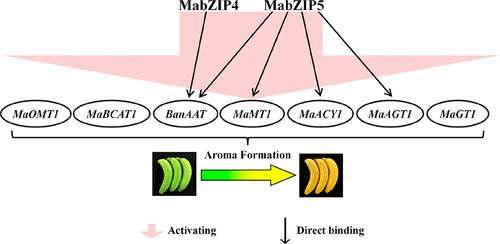Appealing finding suggests why refrigeration dampens banana aromas

Bananas are one of the world's most popular fruits. But how they're stored prior to reaching grocery shelves can adversely affect their flavor and smell. Now in a study appearing in ACS' Journal of Agricultural and Food Chemistry, scientists report that cold temperatures suppress the activity of proteins that play a key role in the formation of the banana's distinct aromas. They say this discovery could lead to enhancements of the fruit's fragrance and flavor.
Billions of bananas are devoured worldwide every year. A typical American eats about 11 pounds of this fruit annually, according to the U.S. Department of Agriculture. Most bananas are grown overseas, which means to reach U.S. shores intact, they must be shipped in refrigerated containers. Although chilling delays ripening, it also can damage the fruit and subdue its aroma. Previously, researchers found that proteins called transcription factors (TFs), which help regulate the activity of certain genes, are involved in fruit ripening. Building on this work, Jian-fei Kuang and colleagues wanted to find out if a particular set of TFs play a role in the dampening of aromas in chilled or refrigerated bananas.
The scientists stored freshly harvested green bananas either in the cold or at room temperature. Once removed from storage, the chilled bananas ripened more slowly than those that had been stored at room temperature, and they had an off-flavor. In a series of experiments, the research team found that refrigeration decreased the activity of aroma-forming genes during ripening. Digging deeper, they detected a pair of TFs called MabZIP4 and MabZIP5 that appear to play an important role in activating these genes. The researchers conclude that a better understanding of this regulatory process could lead to strategies to make bananas smell even better.
More information: Yu-fan Guo et al. Identification of Two Transcriptional Activators MabZIP4/5 in Controlling Aroma Biosynthetic Genes during Banana Ripening, Journal of Agricultural and Food Chemistry (2018). DOI: 10.1021/acs.jafc.8b01435
Abstract
The transcriptional regulation of aroma formation genes remains poorly understood in the banana. In this work, we found that the expressions of a subset of aroma biosynthetic genes including MaOMT1, MaMT1, MaGT1, MaBCAT1, MaACY1, MaAGT1, and BanAAT, as well as two bZIP genes, MabZIP4 and MabZIP5, were down-regulated when prestored at 7 °C compared to those prestored at 22 °C during the ripening process of banana. Furthermore, MabZIP4 and MabZIP5 were shown to be able to activate the transcription of these aroma biosynthetic genes. Importantly, MabZIP4 directly binds to BanAAT promoter, while MabZIP5 binds to the promoters of MaMT1, MaACY1, MaAGT1, and BanAAT via the G-box motif, implicating the diverse functional significances of MabZIPs in controlling aroma biosynthesis in banana. Overall, this work sheds new insights on the understanding of transcriptional regulatory mechanisms associated with aroma formation during banana ripening.
Journal information: Journal of Agricultural and Food Chemistry
Provided by American Chemical Society

















